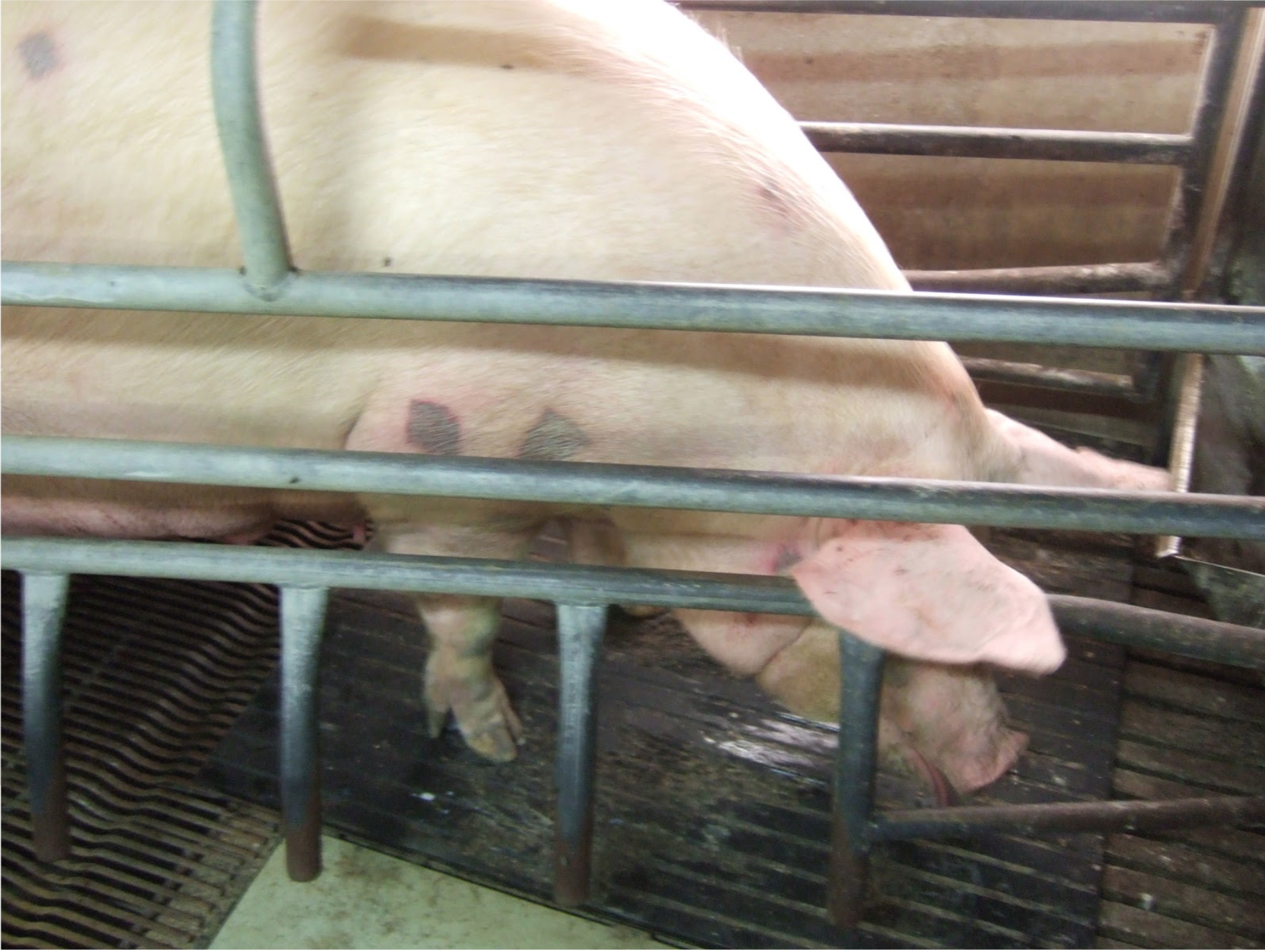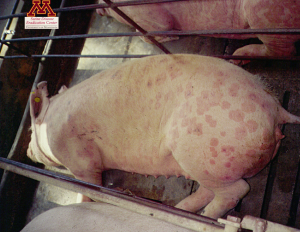Reproductive System
Erysipelas
Clinical importance
Erysipelas is an older swine disease, known from producers in the USA since the 1930s but the bacteria is ubiquitous and present worldwide. Erysipelas, also called diamond-skin disease, can cause issues at all stages of pork production, causing acute septicemia, reproductive issues such as sudden abortions or even lameness. This disease is zoonotic and mainly an occupational hazard since the transmission occurs through cuts or skin punctures. Erysipelas is of particular concern for small populations of pigs, such as hobby farms or pets, because of their easy access to other species, like turkeys and sheep, that harbor the disease.
Etiology and Transmission
There are many strains of Erysipelothrix rhusiopathiae, with serotypes 1a,1b, or 2 causing the majority of cases of swine erysipelas throughout the world. E. rhusiopathiae can be identified as slim, non motile rods that are Gram positive. Healthy-looking pigs are by far the largest reservoir because they can host the bacteria in their tonsils, shed it through their feces and oral fluids without expressing clinical signs. E. rhusiopathiae is spread directly through feces and oronasal secretions and indirectly via environment contaminated by feces and urine from infected animals.
Associated symptoms
Acute form
Signs of an acute form of erysipelas are non-specific. Growing pigs show signs of septicemia such as fever and anorexia, often followed by sudden death. They appear lethargic, show signs of discomfort due to painful joints. Pigs will also show red to purple skin lesions, geometrically shaped. Therefore erysipelas is also known as diamond-skin disease. Sows acutely infected are likely to abort.
Subacute form
The subacute version is less dramatic. The mortality is not as high, the fever is not as severe and the skins lesions more sparse. However, infertility remains with smaller litter sizes sometimes accompanied by mummies.
Chronic form
When a pig survives the more acute forms of erysipelas, it becomes chronically infected, displaying signs of arthritis associated with lameness and a reduction in feed intake. Another possible symptom of chronic erysipelas is vegetative valvular endocarditis, impairing blood circulation, and resulting in lethargy, cyanosis, pulmonary edema, respiratory signs, and sometimes sudden death. Boars can also be affected by this disease, displaying fever and infertility for 6 to 8 weeks.
What is the main reservoir of E.rhusiopathiae?
- Humans
- Turkeys
- Soil
- Pigs
Associated lesions
Macroscopic lesions
The pathognomonic lesions of swine erysipelas are rhomboid-shaped, slightly raised, red or purple skin lesions found most commonly on the flanks and abdomen of the pig . Other lesions observed are enlarged and congested lymph nodes, congested lungs, and enlarged spleen. Enlarged joints caused by swollen synovial tissues and accumulation of fluids can be seen as well. Vegetative valvular endocarditis, or cauliflower looking lesions on the heart valves can be found in chronically affected pigs.


Figure 1 – Rhomboid, purple, slightly raised skin lesions pathognomonic of an erysipelas infection. | Source: Dr. Perle Zhitnitskiy (left), Dr. Carlos Pijoan (right)
Microscopic lesions
Blood vessels tend to display most of the lesions caused by acute erysipelas. Capillaries are often congested, and the vessels may be obstructed by blood clots resulting in necrosis. Lymph nodes are also affected, usually by hemorrhages and a large number of neutrophils. Chronic arthritis leads to thickened synovial membranes of affected joints.
Which lesions are pathognomonic of swine erysipelas?
- Valvular Vegetative Endocarditis
- Rhomboid, purple skin lesions
- Chronic arthritis
- Abortions and mummified fetuses
Diagnostic
Quick diagnosis of erysipelas is important, as antibiotic treatments work quite well as long as the disease is caught early. Clinical observation of the diamond-shaped skin lesions is very indicative of an erysipelas infection. E. rhusiopathiae is easily cultured from infected tissues such as the heart and spleen as long as the samples are not contaminated and the pig has not been treated with antibiotics. PCR on oral fluids, serum samples or tissues, provides a good turn-around time and is a reliable diagnostic method. However, it is important to remember that between 30 and 50% of healthy pigs carry E.rhusiopathiae in their tonsils; therefore the detection of the bacteria needs to be associated with clinical signs to be conclusive. Serology tests are also available but their interpretation is complicated by the vaccination.
Differential Diagnosis
Septicemia
Other septicemia causing diseases that affect a similar age of pigs are include infection by Salmonella choleraesuis, Actinobacillus suis and A.pleuropneumoniae, Heamophilus parasuis and Streptococcus suis.
Skin lesions
The differential for skin lesions should include Porcine Circovirus type 2, Classical Swine Fever, and Pityriasis rosea.
Treatment, Prevention and Control
The most widely used treatment for erysipelas is penicillin. However, strains of Erysipelothrix rhusiopathiae can be treated with a wide range of antibiotics. Early treatment in the course of infection often produces a good response within a day. There are also two common types of vaccines used. The first contains inactivated bacterins and is administered via intramuscular infection and is usually administered to the sows in combination with Parvovirus and Leptospirosis valances. Vaccination protects the dam against reproductive clinical signs. The second vaccine is a live avirulent vaccine that can be administered to the whole herd via drinking water, usually to growing pigs. Both are safe, cheap, and effective.
Since the transmission of erysipelas is oronasal, cleaning and disinfection of the barns is essential in preventing outbreaks. E. rhusiopathiae is sensitive to most disinfectants but can be hard to eliminate if organic matter is present.
What is the treatment of choice for erysipelas?
- Enrofloxacin
- Ampicillin
- Ceftiofur
- Penicillin

